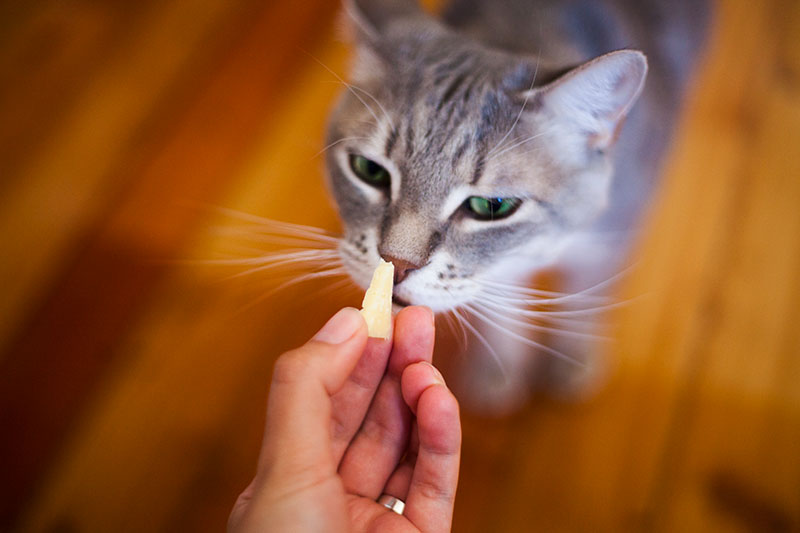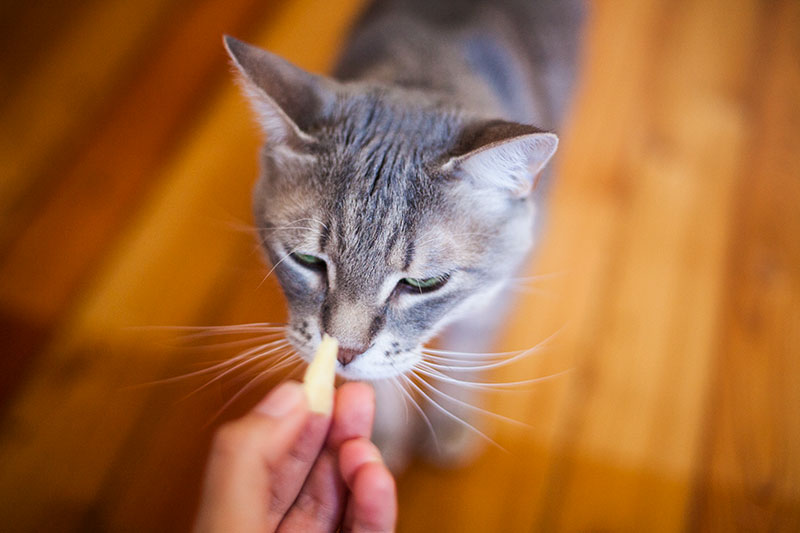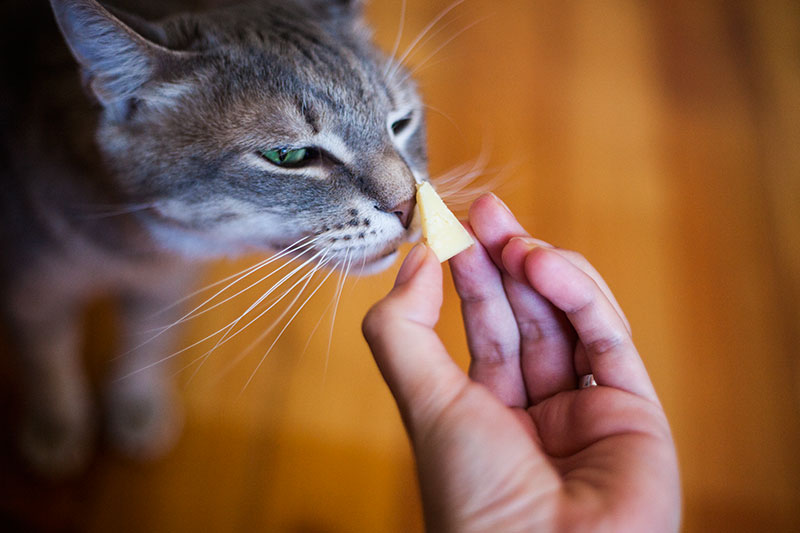I’ll admit to being a cat owner who freely offered her cat a little bit of cheese as a snack long before looking up whether or not it was actually safe for cats to ingest. As a new cat owner, I knew not to offer up just any foods to my furry feline, as I knew many “human” foods that appeared harmless could possibly be extremely dangerous for pets to ingest, but in the back of my mind cheese was always a safe bet to give so long as I didn’t offer too much of it.
Now that I’ve had this cat blog a while, I’ve become a lot more interested in where the fine line of “too much” or “could an equivalent be better?” lies. There’s always more to the story even if your intuitions right off the bat are spot on. So I did a little digging, and here’s what I found out about the cats + cheese combination. Let me know if your intuitions were also right about this subject.

Can Cats Eat Cheese?
Yes, cats can eat cheese.
Now, we’re talking about regular plain ‘ol cheese here with no extra ingredients besides the typical “milk, cheese cultures, salt, and enzymes” combo. If you’re wondering whether a specific cheese you had in mind that has some extra ingredients in it is safe for cats to eat, you’re going to have to look up those ingredients one at a time. But I pretty much just mean basic no-extra-ingredients cheese when I’m talking about cheese here, so keep that in mind.
To reiterate: cheese that lists milk, cheese cultures, salt, and enzymes as the only ingredients are the cheeses we’re talking about. Any extra ingredients please look up separately as those may not be safe for cats.
A lot of websites insist repeatedly that cats shouldn’t be ingesting cheese because they’re all pretty much lactose intolerant, and you know what, while that’s obviously true, it doesn’t mean you need to keep your cat off the yummy dairies entirely. Moderation, as with everything in life, is key.
So yes, you giving your dairy-loving four-legged fella of the house a small cheese cube when you have a house party, and guests are walking around making him jealous as they chomp one square after another – perfectly fine. You giving your feline man of the household a quarter block of cheese for dinner because you forgot to buy kibble on your way home, obviously not okay. But let’s get into why cheese could be an issue in the next section…
Is It Ever Dangerous for Cats to Eat Plain Cheese?
Since cats are lactose intolerant, giving your cat too much cheese leads to some pretty unpleasant results. What are these?
The Side Effects of Cats Eating Too Much Cheese
- Upset stomach
- Gas
- Diarrhea
Ever had lactose intolerance yourself? If not, know someone who’s had it? It’s not very comfortable, and it won’t be comfortable for your cat either. They get the same gas issues, the same runs, and the same upset tummy we would were we to mix lactose intolerance + too much dairy. Avoid giving your cat too much cheese.
How Much Cheese Is Too Much?
But how much cheese can you give without it being too much?
Sorry to say – it depends on the cat. Every cat will have varying tolerance to lactose.
Also, it depends on the cheese. Different cheeses have varying amounts of lactose in them. Aged cheeses have lower lactose than younger cheeses; goat cheeses have less lactose than cheeses made from cow’s milk. Curious about how much variance there can be from cheese to cheese? Check out this interesting list of lactose percentages of dairy products. Apparently some American processed pasteurized cheeses are up to 14.2% lactose?? The median is something like 2 or 3 per cent, so that feels entirely mad! Obviously, now knowing the enormous gap between these numbers, you’ll now get why the particular cheese you’re offering up makes a lot of difference to how much you should bottom line dole out to a cat.
I know that’s not something you likely wanted to hear because if you’re reading this section, you probably wanted a definite answer to the question “How much cheese is too much?” But don’t worry; I have a simple little test that will help you see whether your cheesy generosity is simply too much for your cat.
What’s the test you ask? Give your the amount of cheese you feel would be appropriate, then be diligent about checking for symptoms of lactose intolerance for the next few hours up to a day (again, the symptoms are: upset stomach, gas, and/or diarrhea). Notice a slightly runny loo visit or the unpleasant smell of a kitty cat farting? You’ve given too much.
A Particular Time When Cheese Is Dangerous: Medicine Conflicts
Dr. Tawnia Shaw, DVM, the vet behind The Happy Pet Vet, pointed out in an interview with PetMD that “some medicines do not do well if taken with high calcium foods. Doxycycline, an antibiotic, for example, gets bound to the calcium and then does not get absorbed.”
So if your cat is on any kind of medication, make ultra extra sure to double check with your vet that it’s okay he or she has cheese while on this medication. Or honestly, skip the cheese altogether if your cat happens to be on medication – just to be on the safe side. It’s also a good idea to check if the medication your cat is going to be on will have any other food related conflicts.
Wanted to use cheese to hide medicine pills you need to convince your cat to eat? Need an easy way to get pets to take their medication that’s not harmful at all? Try 100% petroleum jelly – the non-scented kind. It’s a very effective, highly non-toxic home remedy for helping cats pass hairballs, and should work like a charm for getting cats to swallow medications and pills as well. You can also try specially made cat treats that come with holes in them for you to insert medicine tablets or capsules, like Greenies Pill Pockets, as I mentioned in my article about whether peanut butter was safe for cats.

Which Types of Cheese Can Cats Eat Safely?
Absolutely always make sure to check the ingredient list before feeding cheeses to your cat, but if we’re talking the standard milk, cheese cultures, salt, and enzymes combo that’s the baseline for most cheeses, we’re talking safe in small amounts (though obviously watch for reactions; again, if your cat has upset stomach, gas, and/or diarrhea – it was too much cheese for him/her).
So what about specifically these types of cheeses –
- Cheddar Cheese,
- Cottage Cheese,
- Cream Cheese,
- Parmesan Cheese,
- Feta Cheese, &
- String Cheese
Yup, yup, yup. Correct me if I’m wrong, but these should all be fine for a cat to eat in small amounts.
Again – here’s the ever so insightful list of lactose percentages of dairy products in case you want to figure out which cheeses to look into buying to make sure your cat has the least lactose even though he or she wants cheese a little more regularly than the average cat. Obviously, the exact lactose percentage varies from cheese to cheese, but based on the list, Camembert looks like a kickass option no matter how high the lactose percentage gets. On the other end, some American cheeses, processed ones especially, seem like they could be very bad picks.
What About Eggs and Cheese?
Not only is it true that cats can eat cooked eggs safely (both egg whites and egg yolks) – eggs are actually very healthy snacks for cats and have been deemed one of the most nutritionally complete sources of protein for both humans and animals – which is awesome!
Cats can definitely not live off of eggs alone, so you can’t just give your cat eggs and cheese for supper, but a small egg and cheese snack is perfectly fine to be delving over if your cat eyes it on your plate and meows for a nibble.
Alternative Snacks to Feed Cats
I’ve done a few of these “can cats eat x” articles already, and of the ones I’ve done, lettuce and eggs were the top two “human” foods to feed cats as snacks. Eggs because they’re damn close to being nutritionally complete, and lettuce because of the fiber content, because eating lettuce can help your cat stay hydrated, and actually quite a slew of other perks, so look into that article in case you’re interested in trying to offer your cat lettuce.
No matter what snack or snacks you end up offering your cat, you’ll need to make sure that all snack foods combined (and yes, that includes those addictive dental treats you picked up for Fluffy last week!) don’t exceed 10% of your cat’s overall diet. Snacks are like junk food and take out dinners – absolutely fine in small doses, but if they take up too much of a cat’s diet, the cat will either gain weight or have a diet that’s not nutritionally complete. So watch those rations, or instead use my favourite cat snack trick: buying a second nutritionally complete cat food that’s made of a different protein source (like salmon if I’m giving my cat chicken-based kibble as a main meal) to use as a “treat” instead of human foods and cat treat biscuits. There’s no going wrong with giving two healthy foods – one as a main meal and one as a snack/treat!

What Do You Think About Cats + Cheese?
What are your thoughts on giving a cat cheese as a snack? Do you do it? How much do you give? How frequently would you offer cheese?
Has your cat ever had an averse reaction to the lactose in cheese? Did you know there was so much variance in lactose percentages from one cheese to the next?
Any cats + cheese related thoughts and stories – please post in the comments down below!

Speaking of cats; the comment “because they’re pretty much all lactose intolerant” astonishes me. I am 92 years old, and as far back as I can remember, which admittedly is sometimes not far, the traditional saucer of milk has been the basic intake for the family house cat, the barn cat and the cat waiting by the milking pail for a squirt of milk directly from the cows teat. There is a giant disconnect here somewhere. I find that statement very difficult to accept. Being the crotchety old man that I am, I attribute that belief to some brand new veterinarian trying to become an animal guru in a hurry.
You are correct. Cats can and do eat many things that people would not expect if they are accustomed to it.
I ended up cohabitating with an entire family of street cats (in a poorer part of Asia) and in addition to milk they’ll eat cheese, tofu, pumpkin, and even rice. I’ve never seen a cat eat any fruit but otherwise they’re curious about most anything.
I’m trying to put weight back on a 16-year-old cat, J.B. We cleared up the cause of the weight-loss (worms, ick) and he had a clean senior blood panel at the vet, so now it’s just building back the lost weight. Every morning he gets an after-breakfast cheese snack of aged sharp cheddar. I started him up gradually, but no signs of intestinal distress. He’ll eat up to a full slice–90 calories!–without digestive issues but that much cuts into his consumption of his regular food. I’m still working out how much snack he can eat without ruining his supper.
There’s a lot of information about helping your cat lose weight–much of it contradictory–but not as much on fostering weight gain.
I am trying to get one of my cats to eat some Dave’s chicken canned food (which actually smells like chicken!). I got 12 of them from Amazon and can get him to start eating it if I put a little tuna on top but I was thinking of adding some grated hard cheese so he likes the taste better. So thanks for your thoughts on cheese – very helpful 🙂
No problem! Good luck with getting him to eat the cat food 🙂
A month ago I addopted a 3yr old cat from a local shelter. She had been there since she was a kitten. She will only eat purina pro plan chicken kibble. I have tried to get her to eat wet food but she says absolutely not! I’ve offered healthy human food but nope. I was sittig here munching on sharp chedder cheese and she actually ate a few small pieces. I googled if it was ok and found your site. So glad I did, can’t wait to read more of your articles, keep em coming, Linda
Thanks, Linda! Will definitely keep them coming. As a tip – you may want to try “transitioning” her to another food (like a wet food or another kibble if you prefer), by mixing the kibble she loves with the new food. So start with a lot of the one she loves and teensy bits of the new food, then keep increasing the amount of new food and decreasing the amount of the kibble she’s hooked on. It should help her eat at least half if not wholly something else; if you’d prefer her being on another cat food.
This is a marvellous article. We have three cats and its our eldest who is known as the ‘cheese monster’. She has what I call her ‘cheese please face’ on the rare occasion we are eating cheese ourselves and we always give her a little bit which she loves. No ill effects to report and she’s 5 years old but we make sure we don’t over do it!
Oh my god I need to see the “cheese please face.” That sounds tooooo cute for words <3 I love the nickname "cheese monster," too. It's amazing.
Good on you for not overdoing it; it can be hella hard to say "no more" to those adorable faces they pull!
My cat is 13 years old and constantly begs for human food, whatever it is! She’s the most demanding cat I’ve ever met, it’s honestly adorable. Anytime you give in and let her have a little snack, she’ll spend the rest of the day trying to crawl into your lap and purr all over you! Recently she’s started going absolutely nuts over my cottage cheese, so I’ll definitely try giving her a chunk next time!
Being vegan, we have no cheese in the house, but years ago, Chuck and Angel would get a bit of cheddar or yogurt. Nowadays, The Hubby monitors their food closely, and it’s only canned food, and I got yelled at yesterday when I suggested that I sneak some kibble to them once in a blue moon!
Scolding you over sneaking them a little kibble from time to time – that’s too funny; actually snickered out loud reading that. You should get him a mug that reads, “Overprotective Cat Dad” for Christmas and fill it with kibble 😉